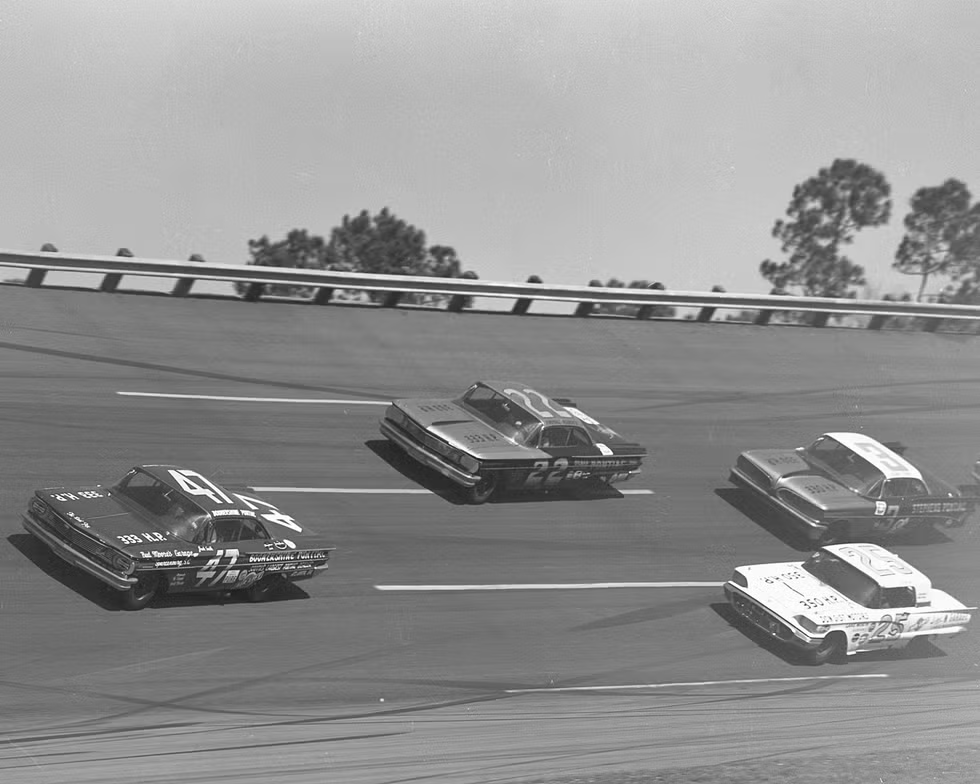- Although Jack Smith grew up in Georgia, he indeed was born in the southern Illinois town of Metropolis.
- It isn’t a stretch to tag Smith as a hero.
- He was one of NASCAR’s pioneer drivers, part of the take-no-prisoners wave of daredevils who ran—and won—on pockmarked dirt bullrings.
It was a comparison Jack Smith enjoyed making.
“I’m from Metropolis. Same place as Superman, right?” he would say, smiling.
Although Smith grew up in Georgia, he indeed was born in the southern Illinois town of Metropolis. Superman, the comic book hero, was based in a fictional town named Metropolis.
It isn’t a stretch to tag Smith as a hero. He was one of NASCAR’s pioneer drivers, part of the take-no-prisoners wave of daredevils who ran—and won—on pockmarked dirt bullrings. They advanced, along with the sport, to super-fast superspeedways that challenged the bravery of drivers and the endurance of their fast cars.
He drove in the first Cup (then Strictly Stock) race in Charlotte in 1949. He ran in the first superspeedway race at Darlington Raceway in 1950. He almost won the first World 600 at Charlotte in 1960. He ran test laps on the then-new Atlanta track in 1960 before guardrails were installed. He flew over the fence at Darlington in a dramatic crash, escaping injury.
By the time he retired in 1964, he had won 21 Cup races, the same number as NASCAR Hall of Fame members Benny Parsons and Bobby Labonte.
Surprisingly to some, Smith has not been nominated for the NASCAR Hall of Fame, nor was he chosen as one of NASCAR’s 75 Greatest Drivers as the sport celebrated its 75th anniversary this year. Only a handful of eligible drivers have won more than 20 Cup races and are not in the hall.
Smith seems to be in the mushy middle of drivers who “almost” got there. (He was elected to the National Motorsports Press Association’s Hall of Fame—its members chosen by news media representatives—in 1981).
Smith, a resident of Spartanburg, South Carolina, where he had operated an automatic transmission shop for decades, died in 2001 at the age of 78.
Smith raced when safety was largely an afterthought and when a rough-handling car could leave a driver’s hands bloody after 100 laps on a bumpy dirt track.
“There’s very few drivers today that would be successful then,” Smith said in one of his final interviews before his death. “They don’t know how tough it was to get out of a car and blood be running out of your hands. You didn’t want to do it, but if you wanted to make a living, you had to keep going.
“I don’t believe they could go out there and sleep in the car all night and get in the race car, go racing, get in the truck and tow the car from Charleston (South Carolina) to Jacksonville (Florida) to Savannah (Georgia) to Martinsville (Virginia) and run a long race the next day. I don’t think there are many of them who love it enough to stay with it like we did then. Most of them are in it for the money and the glory. Back then you were in it because you loved it.”
Barrel-chested with broad shoulders, Smith had the physique to be a success in racing’s early years, when strong-arming and power-sliding a race car through dirt-track turns required a certain skill level. And more than a dash of daring.
He started driving in the Atlanta area after attending races at the old Lakewood Speedway with his father. Soon Smith became a reliable winner at Lakewood, a tough one-mile oval, and the Peach Bowl, a quarter-mile track. In the early 1950s, he won so many times at the Peach Bowl that fans would call the track to ask which driver finished second, he said.
Smith was a star in Sportsman and Modified racing even as he edged into the Cup Series with one start in 1949, three in 1950 and seven in 1951. He won Cup races at an assortment of tracks—from the high speeds of Daytona Beach to the ragged dirt of long-gone short tracks.
The inaugural 1960 World 600 should have been the star-making race for Smith. Contested on the 1.5-mile Charlotte Motor Speedway, a new racing surface that was finished hurriedly, the 600 turned into a chaotic event. Pieces of the track came up during the event, and officials allowed teams to put screens in front of their cars to prevent debris from clogging radiators.
“It was like driving through a battlefield,” Smith said. “Everybody was putting all kinds of strange stuff on their cars to get through it.”
Racing through the madness, Smith led 198 of 400 laps. He had a staggering seven-lap lead late in the race but ran over a piece of debris, puncturing his gas tank. His crew tried desperately to plug the leak with rags, but NASCAR eventually ordered the car off the track because it was spraying fuel into the grandstands.
Various problems—some caused by the track surface—eliminated more than half of the 60-car starting field. Smith finished 12th. Friends consoled him as he cried in the pits afterward.
Even for a tough guy like Smith, it was a crushing loss.
He would win eight more Cup races before retiring















